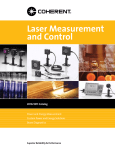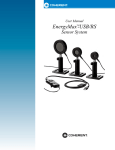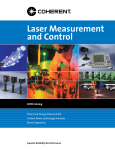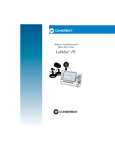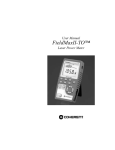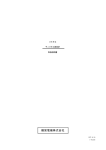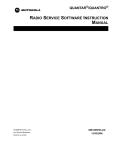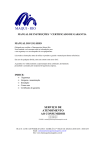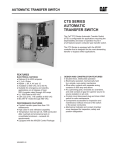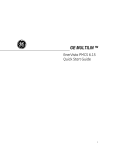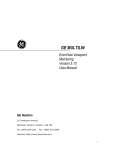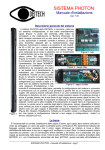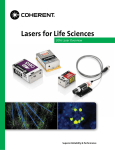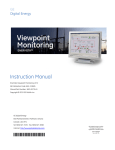Download EnergyMax Sensors User Manual
Transcript
User Manual EnergyMax™ Sensors User Manual EnergyMax Sensors 27650 SW 95th Ave. Wilsonville, OR 97070 EnergyMax Sensors User Manual This document is copyrighted with all rights reserved. Under the copyright laws, this document may not be copied in whole or in part or reproduced in any other media without the express written permission of Coherent, Inc. Permitted copies must carry the same proprietary and copyright notices as were affixed to the original. This exception does not allow copies to be made for others, whether or not sold, but all the material purchased may be sold, given or loaned to another person. Under the law, copying includes translation into another language. Coherent and the Coherent Logo are registered trademarks of Coherent, Inc. EnergyMax is a trademark of Coherent, Inc. Every effort has been made to ensure that the data given in this document is accurate. The information, figures, tables, specifications and schematics contained herein are subject to change without notice. Coherent makes no warranty or representation, either expressed or implied with respect to this document. In no event will Coherent be liable for any direct, indirect, special, incidental or consequential damages resulting from any defects in its documentation. Technical Support In the U.S.: Should you experience difficulties with your product, or need technical information, please visit our website: www.Coherent.com. You can obtain additional support by either telephoning our Technical Support Hotline at 1.800.343.4912, or e-mailing our Support Team at [email protected]. Telephone coverage is available Monday through Friday (except U.S. holidays). If you call outside our office hours, your call will be taken by our answering system and will be returned when the office reopens. If there are technical difficulties with your product that cannot be resolved by support mechanisms outlined above, please e-mail or telephone Coherent Technical Support with a ii description of the problem and the corrective steps attempted. When communicating with our Technical Support Department, via the web or telephone, the model and serial number of the product will be required by the Support Engineer responding to your request. Outside the U.S.: If you are located outside the U.S., visit our website for technical assistance, or telephone our local Service Representative. Representative phone numbers and addresses can be found on the Coherent website, www.Coherent.com. Coherent provides web and telephone technical assistance as a service to its customers and assumes no liability thereby for any injury or damage that may occur contemporaneous with such services. These support services do not, under any circumstances, affect the terms of any warranty agreement between Coherent and the buyer. Operating a Coherent product with any of its interlocks defeated is always at the operator's risk. iii EnergyMax Sensors User Manual iv Table of Contents TABLE OF CONTENTS Preface .......................................................................................................... ix U.S. Export Control Laws Compliance ........................................................ ix Publication Updates ...................................................................................... ix Symbols Used in This Document ...................................................................x Safety ...................................................................................................................1 Environmental Regulations.............................................................................2 RoHS Compliance .................................................................................2 Waste Electrical and Electronic Equipment (WEEE, 2002) ..................2 Declaration of Conformity..............................................................................3 Description .......................................................................................................5 Unpacking and Inspection ..............................................................................6 Post and Stand Assembly................................................................................7 Product Overview ...........................................................................................8 MaxBlack EnergyMax Sensors..............................................................8 Diffuse Metallic EnergyMax Sensors ..................................................11 MaxBlack EnergyMax Sensors With Diffusers ...................................13 MaxUV EnergyMax Sensors ...............................................................15 Quantum EnergyMax Sensors .............................................................17 Technical Description ..............................................................................21 Increasing Average Power With Heat Sinks .................................................21 Pyroelectric Technology ...............................................................................23 Damage Thresholds ......................................................................................25 Measurement Linearity .................................................................................25 Energy Linearity ..................................................................................26 Repetition Rate Linearity.....................................................................26 Average Power Linearity .....................................................................26 Temperature LInearity of Quantum EnergyMax Sensors ....................27 Pulse Width Linearity ..........................................................................28 v EnergyMax Sensors User Manual Spectral Response .........................................................................................28 Applying Wavelength Compensation Accuracy ..................................29 Operation ........................................................................................................33 Care of EnergyMax Sensors .........................................................................33 How to Measure Laser Pulse Energy............................................................34 How to Measure Energy With an Oscilloscope ............................................38 Calibration and Warranty ...................................................................41 Coherent Calibration Facilities and Capabilities ..........................................41 Optical Calibration Method ..........................................................................42 EnergyMax NIST Traceable Optical Calibration ................................42 Recertify Once a Year ..........................................................................43 Calibration Fundamentals ....................................................................43 Calculation of Responsivity (Rv) ........................................................45 Calibration Verification........................................................................45 Limited Warranty ..........................................................................................46 Extended Warranty........................................................................................46 Warranty Limitations ....................................................................................47 Obtaining Service .........................................................................................48 Product Shipping Instructions.......................................................................49 Appendix A: Frequently Asked Questions ................................53 Index ..................................................................................................................57 vi Table of Contents LIST OF TABLES 1. 2. 3. 4. 5. 6. 7. 8. 9. 10. 11. 12. 13. 14. 15. MaxBlack EnergyMax Sensor Selection Chart ...........................................8 MaxBlack EnergyMax Sensor Specifications ...........................................10 Diffuse Metallic EnergyMax Sensor Selection Chart................................11 Diffuse Metallic EnergyMax Sensor Specifications..................................12 MaxBlack EnergyMax Sensor With Diffusers Selection Chart.................13 MaxBlack EnergyMax Sensor With Diffusers Specifications...................14 MaxUV EnergyMax Sensor Selection Chart.............................................15 MaxUV EnergyMax Sensor Specifications ...............................................16 Quantum EnergyMax Sensor Selection Chart ...........................................17 Quantum EnergyMax Sensor Specifications .............................................19 Average Power Ratings..............................................................................22 Available Heat Sinks..................................................................................23 Damage Thresholds ...................................................................................25 Wavelength Compensation Accuracy ........................................................30 Coherent Service Centers...........................................................................49 LIST OF FIGURES 1. 2. 3. 4. 5. 6. 7. Waste Electrical and Electronic Equipment Label.......................................2 Typical Dynamic Range Curves of Quantum EnergyMax Sensors...........18 Pyroelectric Current and Voltage Response...............................................24 Photo Sensitivity Temperature Characteristics ..........................................27 Spectral Absorption of EnergyMax Sensor Coatings ................................31 Spectral Sensitivity of EnergyMax Sensors With Diffusers ......................32 Ratiometric Method of Optical Calibration ...............................................44 vii EnergyMax Sensors User Manual viii Preface Preface This manual contains user information for the Coherent EnergyMax sensors. TM U.S. Export Control Laws Compliance It is the policy of Coherent to comply strictly with U.S. export control laws. Export and re-export of lasers manufactured by Coherent are subject to U.S. Export Administration Regulations, which are administered by the Commerce Department. In addition, shipments of certain components are regulated by the State Department under the International Traffic in Arms Regulations. The applicable restrictions vary depending on the specific product involved and its destination. In some cases, U.S. law requires that U.S. Government approval be obtained prior to resale, export or re-export of certain articles. When there is uncertainty about the obligations imposed by U.S. law, clarification should be obtained from Coherent or an appropriate U.S. Government agency. Publication Updates To view information that may have been added or changed since this publication went to print, connect to www.Coherent.com. ix EnergyMax Sensors User Manual Symbols Used in This Document This symbol is intended to alert the operator to the presence of dangerous voltages associated with the product that may be of sufficient magnitude to constitute a risk of electrical shock. This symbol is intended to alert the operator to the presence of important operating and maintenance instructions. x Safety SAFETY Carefully review the following safety information to avoid personal injury and to prevent damage to this product or any equipment connected to it. There are no user-serviceable parts in Coherent EnergyMax sensors. For service information, refer to “Obtaining Service” on page 48. Do not operate the system if its panels are removed or any of the interior circuitry is exposed. Do not operate the system in wet or damp conditions, or in an explosive atmosphere. Do not operate the system if there are suspected failures. Refer damaged units to qualified Coherent service personnel. 1 EnergyMax Sensors User Manual Environmental Regulations RoHS Compliance These Coherent products are RoHS (EU Restriction of Hazardous Substances) compliant. Waste Electrical and Electronic Equipment (WEEE, 2002) The European Waste Electrical and Electronic Equipment (WEEE) Directive (2002/96/EC) is represented by a crossed-out garbage container label (Figure 1). The purpose of this directive is to minimize the disposal of WEEE as unsorted municipal waste and to facilitate its separate collection. Figure 1. Waste Electrical and Electronic Equipment Label 2 Safety Declaration of Conformity 3 EnergyMax Sensors User Manual 4 Description DESCRIPTION This section discusses: • Unpacking and inspection (page 6) • Post and stand assembly (page 7) • Product overview (page 8) • MaxBlack EnergyMax sensors (page 8) • Diffuse Metallic (page 11) • MaxBlack EnergyMax diffusers (page 13) • MaxUV EnergyMax sensors (page 15) • Quantum EnergyMax sensors (page 17) 5 EnergyMax sensors sensors with EnergyMax Sensors User Manual Unpacking and Inspection All Coherent EnergyMax sensors are carefully tested and inspected before shipping. TM Save the inner carton to store the sensor when not in use and to ship the sensor to Coherent for calibration. Inspect each of the following items for damage: • The EnergyMax sensor • Post and stand components (see the illustration on page 7) • Damage test slide (only included with sensors that do not have a built-in diffuser window) • Heat sink, if ordered (optional accessory) • This manual Advise Coherent immediately of any shortages or damage (refer to “Obtaining Service” on page 48). A Returned Material Authorization (RMA) will be issued for any damaged sensor (refer to “Product Shipping Instructions” on page 49). 6 Description Post and Stand Assembly Post Thumbscrew Post Holder Stand 1 /4-20 SHC Screw (supplied) Hex Key (supplied) 7 EnergyMax Sensors User Manual Product Overview Coherent EnergyMax sensors are known as “smart” sensors—that is, they incorporate onboard electronics that automatically correct for pyroelectric sensor temperature, as well as built-in wavelength compensation factors. This section gives an overview of each of the five types of sensors that comprise the EnergyMax Family: MaxBlack, Diffuse Metallic, MaxBlack With Diffusers, MaxUV, and Quantum. MaxBlack EnergyMax Sensors The MaxBlack EnergyMax series consists of six different models that allow measurement over a wide range of wavelengths, beam diameters, average power levels, and repetition rates. All MaxBlack EnergyMax sensors feature the MaxBlack coating, which offers significantly better damage resistance and mechanical durability characteristics compared to black paint coatings. Table 1. MaxBlack EnergyMax Sensor Selection Chart ACTIVE AREA DIAMETER CALIBRATION WAVELENGTH 1064 nm 10 MM 25 MM 50 MM J-10MB-LE J-25MB-LE J-50MB-LE J-10MB-HE J-25MB-HE J-50MB-HE 8 Description The 25 and 50 mm diameter sensors accept a user-installable, optional heat sink (see “Increasing Average Power With Heat Sinks” on page 21), which can extend the energy and/or repetition rate range. These heat sinks allow 25 mm sensors to be used up to 15W average power, and 50 mm sensors to be used up to 24W average power. Use of EnergyMax sensors at average power levels beyond the base model average power specification—without the optional heat sink—may cause permanent damage to the sensor. MaxBlack EnergyMax Sensors are compatible with Coherent LabMax-TOP, 3sigma, FieldMaxII-TOP, FieldMaxII-P, EPM1000, and EPM2000 meters. 9 EnergyMax Sensors User Manual Table 2. MaxBlack EnergyMax Sensor Specifications J-50MB-HE J-50MB-LE J-25MB-HE J-25MB-LE J-10MB-HE J-10MB-LE Energy Range 1 mJ -2J 250 µJ - 500 mJ 500 µJ - 1J 25 µJ - 50 mJ 10 µJ - 20 mJ 300 nJ - 600 µJ Noise Equivalent Energy < 33 µJ < 8 µJ < 16 µJ < 1 µJ < 0.5 µJ < 20 nJ Wavelength Range (µm) 0.19 - 12 0.19 - 12 0.19 - 12 0.19 - 12 0.19 - 12 0.19 - 12 Active Area Diameter (mm) 50 50 25 25 10 10 Max. Avg. Power (W)a 10 10 5 5 4 4 Max. Pulse Width (µs) 17 17 17 17 17 17 Max. Rep. Rate (pps) 300 300 1000 1000 1000 1000 Max. Energy Density (mJ/cm2) (@ 1064 nm, 10 ns) 500 500 500 500 500 500 MaxBlack MaxBlack MaxBlack MaxBlack MaxBlack MaxBlack No No No No No No Sensor Coating Diffuser Calibration Wavelength (nm) 1064 1064 1064 1064 1064 1064 Calibration Uncertainty (%) ± 2% ± 2% ± 2% ± 2% ± 2% ± 2% 2.5 2.5 Linearity (%) Cable Length (m) Refer to “Measurement Linearity” on page 25. 2.5 2.5 2.5 2.5 Cable Type J DB-25 J DB-25 J DB-25 J DB-25 J DB-25 J DB-25 Item Number 1110573 1110576 1110746 1110743 1110843 1110855 a. The maximum average power specification in the table above is when the sensor is used without a heat sink. See “Increasing Average Power With Heat Sinks” on page 21 for information describing how optional heat sinks can increase the average power handling capability of these sensors. 10 Description Diffuse Metallic EnergyMax Sensors Diffuse Metallic EnergyMax sensors feature broad wavelength coverage (190 nm to 2.1 µm) and large active area (up to 50 mm). This series of EnergyMax sensors consists of three different models that allow measurement over a wide range of wavelengths, beam diameters, average power levels, and repetition rates. These sensors feature a unique diffused metallic coating which offers significantly higher damage resistance than traditional metallic coatings and produces very little specular reflectance, thus eliminating spurious beams that can re-enter the laser cavity. Table 3. Diffuse Metallic EnergyMax Sensor Selection Chart ACTIVE AREA DIAMETER CALIBRATION WAVELENGTH 10 MM 25 MM 50 MM 1064 nm J-10MT-10KHZ J-25MT-10KHZ J-50MT-10KHZ The 25 mm and 50 mm sensors accept a user-installable, optional heat sink (see “Increasing Average Power With Heat Sinks” on page 21), which can extend the energy and/or repetition rate range. These heat sinks allow the J-25MT-10KHZ to be used up to 30W average power, and J-50MT-10KHZ to be used up to 50W average power. 11 EnergyMax Sensors User Manual Use of EnergyMax sensors at average power levels beyond the base model average power specification—without the optional heat sink—may cause permanent damage to the sensor. Diffuse Metallic EnergyMax sensors are compatible with Coherent LabMax-TOP, 3sigma, EPM1000, and EPM2000 meters. Table 4. Diffuse Metallic EnergyMax Sensor Specifications Energy Range J-10MT-10KHZ J-50MT-10KHZ J-25MT-10KHZ 100 nJ to 200 µJ 500 µJ to 1J 50 µJ to 100 mJ Noise Equivalent Energy < 10 nJ < 16 µJ < 2 µJ Wavelength Range (µm) 0.3 to 2.1 0.3 to 2.1 0.3 to 2.1 10 50 25 1 20 10 Active Area Diameter (mm) Max. Avg. Power (W)a Max. Pulse Width (µs) 1.7 1.7 1.7 Max. Rep. Rate (pps) 10000 10000 10000 Max. Energy Density (mJ/cm2) 50 (@ 1064 nm, 10 ns) 500 (@ 1064 nm, 10 ns) 500 (@ 1064 nm, 10 ns) Sensor Coating Diffuser Diffuse Metallic Diffuse Metallic Diffuse Metallic No No No Calibration Wavelength (nm) 1064 1064 1064 Calibration Uncertainty (%) ± 2% ± 2% ± 2% Linearity (%) Cable Length (m) Refer to “Measurement Linearity” on page 25. 2.5 2.5 2.5 Cable Type J DB-25 J DB-25 J DB-25 Item Number 1110856 1110574 1110747 a. The maximum average power specification in the table above is when the sensor is used without a heat sink. See “Increasing Average Power With Heat Sinks” on page 21 for information describing how optional heat sinks can increase the average power handling capability of these sensors. 12 Description MaxBlack EnergyMax Sensors With Diffusers MaxBlack EnergyMax sensors with diffusers are specifically designed for use with very high energy/peak power lasers operating at low repetition rates, such as those based on Nd:YAG, Ruby, Ho:YAG, and Erbium. The YAG/Harmonics sensor can work at 1064 nm, 532 nm, 355 nm, and 266 nm without the need to change diffusers or any other accessories. The J-25MB-IR sensor can operate throughout the 694 nm to 2.1 µm wavelength range. The J-50MB-IR sensor operates from 500 to 2940 nm and is optimized for use with medical lasers. These sensors combine a MaxBlack coating with a diffuser that produces superior damage resistance characteristics. This combination enables operation with lasers that produce either very high energy per pulse or very high peak fluences. Table 5. MaxBlack EnergyMax Sensor With Diffusers Selection Chart ACTIVE AREA DIAMETER CALIBRATION WAVELENGTH 25 MM FOR RUBY TO HO:YAG 50 MM FOR ND:YAG 50 mm for Erbiuma 1064 nm J-25MB-IR J-50MB-YAG J-50MB-IR a. Sensor is rated for a maximum of four minutes continuous use before the sensor must be cooled for at least four minutes (to achieve < 2% measurement non-linearity). These sensors accept a user-installable, optional heat sink (see “Increasing Average Power With Heat Sinks” on page 21), which can extend either the maximum energy or average power range. These heat sinks allow the J-25MB-IR sensor to be used up to 15W average power, and the J-50MB-YAG sensor to be used up to 45W average power. 13 EnergyMax Sensors User Manual Use of EnergyMax sensors at average power levels beyond the base model average power specification—without the optional heat sink—may cause permanent damage to the sensor. MaxBlack EnergyMax sensors with diffusers are compatible with Coherent LabMax-TOP, 3sigma, FieldMaxII-TOP, FieldMaxII-P, EPM1000, and EPM2000 meters. Table 6. MaxBlack EnergyMax Sensor With Diffusers Specifications J-50MB-YAG J-50MB-IR J-25MB-IR 1.5 mJ to 3Ja 1.0 mJ to 3J 1.5 mJ to 3J < 50 < 100 < 50 0.266 to 2.1 0.5 to 3.0 0.532 to 2.1 35 30 12.5 Max. Avg. Power (W) 20 b 15 20 Max. Pulse Width (µs) 340 1000 860 50 30 20 Energy Range Noise Equivalent Energy (µJ) Wavelength Range (µm) Max. Beam Size (mm) Max. Rep. Rate (pps) Max. Energy Density (J/cm2) Sensor Coating 14.0 (@ 1064 nm, 10 ns) 2.8 (@ 532 nm, 10 ns) 0.75 (@ 355 nm, 10 ns) 1.0 (@ 266 nm, 10 ns) > 100 (@ 2940 nm, 100 µs) 5.0 (@ 1064 nm, 10 ns) MaxBlack MaxBlack Diffuser YAG IR IR Calibration Wavelength (nm) 1064 1064, 2940 1064 Calibration Uncertainty (%) ±2 ±2 ±3 Linearity (%) Cable Length (m) MaxBlack Refer to “Measurement Linearity” on page 25. 2.5 2.5 2.5 Cable Type J DB-25 J DB-25 J DB-25 Item Number 1110744 1155722 1110577 a. Modified sensors with higher repetition rate, energy range and/or pulse width are available. Contact Coherent. b. Sensor is rated for a maximum of four minutes continuous use before the sensor must be cooled for at least four minutes (to achieve < 2% measurement non-linearity). 14 Description MaxUV EnergyMax Sensors These sensors are specifically optimized for use with ArF lasers operating at 193 nm and KrF lasers operating at 248 nm, and feature high accuracy and large active areas (up to 50 mm). The EnergyMax series utilizes a unique coating—called MaxUV—that delivers superior long-term damage resistance. Two of the 50 mm diameter models (labeled as “with Diffuser” in the model name) incorporate a DUV quartz diffuser for increased coating damage resistance. Table 7. MaxUV EnergyMax Sensor Selection Chart ACTIVE AREA DIAMETER CALIBRATION WAVELENGTH 25 MM 50 MM (W/ DIFFUSER) 50 MM (W/O DIFFUSER) 193 nm J-25MUV-193 J-50MUV-193 J-50MUV-193 248 nm J-25MUV-248 J-50-MUV-248 J-50-MUV-248 Both sensors accept a user-installable, optional heat sink (see “Increasing Average Power With Heat Sinks” on page 21), which can extend the maximum energy or average power range. These heat sinks allow 25 mm sensors to be used up to 18W average power, and 50 mm sensors to be used up to 43W average power (both at 193 nm). 15 EnergyMax Sensors User Manual Use of EnergyMax sensors at average power levels beyond the base model average power specification—without the optional heat sink—may cause permanent damage to the sensor. MaxUV EnergyMax sensors are compatible with Coherent LabMax-TOP, 3sigma, FieldMaxII-TOP, FieldMaxII-P, EPM1000, and EPM2000 meters. Table 8. MaxUV EnergyMax Sensor Specifications J-25MUV-248 J-25MUV-193 J-50 MUV-248 (W/O DIFFUSER) J-50MUV-248 (W/ DIFFUSER) 125 µJ to 250 mJ 50 µJ to 100 mJ 500 µJ to 1J 500 µJ to 1J < 4 µJ < 2 µJ < 16 µJ < 16 µJ < 4 µJ < 4 µJ 0.19 to 2.1 0.19 to 2.1 0.19 to 2.1 0.19 to 0.266 0.19 to 2.1 0.19 to 0.266 Active Area Diameter (mm) 25 25 50 50 50 50 Max. Average Power (W)a 5 5 10 15 10 18 Energy Range Noise Equivalent Energy Wavelength Range (µm) J-50MUV-193 (W/O DIFFUSER) J-50MUV-193 (W/ DIFFUSER) 125 µJ to 250 mJ 125 µJ to 250 mJ Max. Pulse Width (µs) 43 43 86 86 86 86 Max. Rep. Rate (pps) 400 400 200 200 200 200 Max. Energy Density (mJ/cm2) Sensor Coating 260 200 260 520 200 400 (@ 248 nm, 10 ns) (@ 193 nm, 10 ns) (@ 248 nm, 10 ns) (@ 248 nm, 10 ns) (@ 193 nm, 10 ns) (@ 193 nm, 10 ns) MaxUV MaxUV MaxUV MaxUV MaxUV MaxUV Diffuser No No No DUV No DUV Calibration Wavelength (nm) 248 193 248 248 193 193 Calibration Uncertainty (%) ± 3% ± 3% ± 3% ± 3% ± 3% ± 3% 2.5 2.5 2.5 2.5 2.5 2.5 Cable Type J DB-25 J DB-25 J DB-25 J DB-25 J DB-25 J DB-25 Item Number 1110745 1110741 1146243 1110572 1146237 1110575 Linearity (%) Cable Length (m) Refer to “Measurement Linearity” on page 25. a. The maximum average power specification in the table above is when the sensor is used without a heat sink. See “Increasing Average Power With Heat Sinks” on page 21 for information describing how optional heat sinks can increase the average power handling capability of these sensors. 16 Description Quantum EnergyMax Sensors The Quantum EnergyMax series consists of three different models that provide very low pulse energy measurement down to 20 pJ. Two of the models (J-10SI-LE and J-10SI-HE) incorporate a Silicon photodiode, and one model (J-10GE-LE) incorporates a Germanium photodiode. All three models contain large 10 mm clear apertures and operate at repetition rates from single pulse up to 10 kHz. Table 9. Quantum EnergyMax Sensor Selection Chart ACTIVE AREA DIAMETER 10 mm CALIBRATION WAVELENGTH SENSOR 532 nm Silicon 1064 nm Germanium MODEL J-10SI-LE J-10SI-HE J-10GE-LE The main difference between Quantum EnergyMax sensors and other Coherent EnergyMax sensors is their sensitivity. Quantum EnergyMax sensors are capable of measuring considerably smaller signals than the rest of the EnergyMax sensor line. They do this by utilizing a photodiode—rather than a pyroelectric—element. Due to the quantum nature of their response, photodiode sensors are inherently more sensitive than pyroelectric sensors, which are thermal-based. One consequence of 17 EnergyMax Sensors User Manual this extra sensitivity is the possibility of measurement error or noise from stray modulated light sources (for example, stray reflections or room lights) in a laboratory environment. For this reason, Quantum EnergyMax sensors are designed for use with a small integrated input beam tube, which limits the field of view of the sensor aperture. This tube is removable for alignment purposes and custom applications. The following chart plots the minimum and maximum measurable energy of each sensor across all wavelengths. This chart can be used to determine the measurable energy range for wavelengths other than those in the specifications table (1064 nm and 532 nm). Figure 2. Typical Dynamic Range Curves of Quantum EnergyMax Sensors 18 Description The output of the Silicon and Germanium photodiodes used in the Quantum EnergyMax sensors varies greatly by wavelength. The sensors contain spectral compensation to account for this variation—see “Spectral Response” on page 28—so that measurements are still accurate when used at wavelengths other than the calibration wavelength. Table 10. Quantum EnergyMax Sensor Specifications J-10SI-LE Energy Range J-10SI-HE 20 pJ to 40 nJ (@ 532 nm) J-10GE-LE 200 pJ to 400 nJ (@ 532 nm) 200 pJ to 400 nJ (@ 1064 nm) Noise Equivalent Energy < 1 pJ (@ 532 nm) < 1 pJ (@ 532 nm) < 8 pJ (@ 1064 nm) Wavelength Range (nm) 325 to 900 325 to 900 800 to 1700 Active Area Diameter (mm) 10 10 10 Max. Avg. Power (mW) 6 60 15 Max. Pulse Width (µs) 1 1 1 Max. Rep. Rate (pps) 10000 10000 10000 Sensor Silicon Silicon Germanium Diffuser ND2 ND2 ND2 Calibration Wavelength (nm) 532 532 1064 Calibration Uncertainty (%) ±3 ±3 ±3 Linearity (%) Cable Length (m) Refer to “Measurement Linearity” on page 25. 2.5 2.5 2.5 Cable Type J DB-25 J DB-25 J DB-25 Item Number 1140727 1150146 1140408 19 EnergyMax Sensors User Manual 20 Technical Description TECHNICAL DESCRIPTION This section discusses: Increasing Average Power With Heat Sinks • Increasing average power with heat sinks (this page) • Pyroelectric technology (page 23) • Damage thresholds (page 25) • Measurement linearity (page 25) • Spectral response (page 28) Using a heat sink increases the average power handling capability of EnergyMax sensors. This optional accessory is designed for measuring a pulsed laser at either higher repetition rates or higher energy levels. The average power specification is dependent upon coating and wavelength. The following table provides average power ratings for several wavelength and sensor combinations. Note that 10 mm aperture sensors do not accept heat sinks, 25 mm aperture sensors accept small and medium heat sinks, and 50 mm aperture sensors accept large heat sinks. 21 EnergyMax Sensors User Manual Use of EnergyMax sensors at average power levels beyond the base model average power specification—without the optional heat sink—may cause permanent damage to the sensor. Table 11. Average Power Ratings APERTURE (MM) WAVELENGTH (NM) NO HEAT SINK (W) SMALL HEAT SINK (W) MEDIUM HEAT SINK (W) LARGE HEAT SINK (W) J-10MB-LE and J-10MB-HE 10 1064 4 - - - J-25MB-LE and J-25MB-HE 25 1064 5 10 15 - J-50MB-LE and J-50MB-HE 50 1064 10 - - 24 J-25MUV-193 25 193 5 10 15 - J-25MUV-248 25 248 5 10 16 - J-50MUV-193 (w/o diffuser) 50 193 10 - - 30 J-50MUV-193 (w/ diffuser) 50 193 18 - - 43 J-50MUV-248 (w/o diffuser) 50 248 10 - - 25 J-50MUV-248 (w/ diffuser) 50 248 15 - - 36 J-10MT-10KHZ 10 1064 1 - - - J-25MT-10KHZ 25 1064 10 20 31 - J-50MT-10KHZ 50 1064 20 - - 49 J-50MB-YAG 50 1064 20 - - 48 J-50MB-IR 50 1064 15 - - - J-25MB-IR 25 1064 20 41 62 - SENSOR MODEL 22 Technical Description Table 12 lists the different heat sinks that are available for EnergyMax sensors. Table 12. Available Heat Sinks ITEM NUMBER 1123430 NAME DESCRIPTION EnergyMax small heat sink 1123431 EnergyMax medium heat sink 1123432 EnergyMax large heat sink Pyroelectric Technology Increases average power handling on 25 mm aperture EnergyMax sensors Increases average power handling on 50 mm aperture EnergyMax sensors The EnergyMax sensor line uses a pyroelectric element to measure the energy in a laser pulse. It does this by producing a large electrical charge for a small change in temperature. The active sensor circuit takes the current from the sensor element and converts it to a voltage that the instrument can measure. Figure 3 shows the relationship between the current response of the pyroelectric element and the output voltage of the sensor circuit. The 23 EnergyMax Sensors User Manual relationship between the current response and output voltage response is fixed so the calibrated peak voltage of the output is the integrated energy of the laser pulse. Figure 3. Pyroelectric Current and Voltage Response 24 Technical Description Damage Thresholds The following table lists the damage threshold for different types of EnergyMax sensors at several wavelengths. Table 13. Damage Thresholds SENSOR WAVELENGTH (NM) 193 248 2 MaxBlack EnergyMax Sensors (mJ/cm ) 2 J-10MT-10KHZ (mJ/cm ) J-25MT-10KHZ and J-50MT-10KHZ (mJ/cm2) J-50MB-YAG (mJ/cm ) 355 532 1064 40 170 - 140 250 500 40 40 40 50 50 50 - 390 500 500 150 200 2 266 - - 1000 750 2800 14000 - - - - 1500 5000 200 260 260 300 375 375 J-50MUV-193 (w/ diffuser) (mJ/cm ) 400 520 520 - - - 2 200 260 260 300 375 375 2 J-25MB-IR (mJ/cm ) J-50MUV-193 (w/o diffuser) (mJ/cm2) 2 J-50MUV-248 (w/o diffuser) (mJ/cm ) J-50MUV-248 (w/ diffuser) (mJ/cm2) 400 520 520 - - - 2 200 260 - 300 375 375 Excimer sensors w/ diffuser (50 mm) (mJ/cm ) 400 520 - 600 750 750 Excimer sensors with MaxUV coating (mJ/cm ) 2 Measurement Linearity Coherent has designed the EnergyMax sensor line to greatly diminish several linearity effects common in pyroelectric energy sensors. The outcome of this design effort is enhanced performance that is now better than at any time in the history of pyroelectric pulsed laser energy measurement. 25 EnergyMax Sensors User Manual Energy Linearity Energy linearity across the entire specified energy range of an EnergyMax sensor is +/- 3%. Within 10 to 90% of the energy range specification the sensors are typically linear to +/- 2%. (The J-50MB-IR has a slightly higher energy linearity specification of +/- 3.5%.) Repetition Rate Linearity Repetition rate linearity is +/- 1% when using EnergyMax sensors with 3sigma, FieldMaxII-TOP and FieldMaxII-P within the repetition rate specification of the meter. In practice, the actual error is often much less than 1%. Repetition rate linearity is +/- 1% up to 750 pps when using EnergyMax sensors with EPM1000 and EPM2000, and is +/- 2% at repetition rates greater than 750 pps. Average Power Linearity The pyroelectric crystal is sensitive to temperature at a rate of approximately 0.2% per degree Celsius change in temperature. Historically this has limited the average power to which a sensor can be exposed. Coherent has implemented a temperature compensation circuit into EnergyMax sensors to limit the amount of error associated with operation at higher average powers. This circuit allows measurement of higher pulse energy at faster repetition rates than ever before and enables the use of removable heat sinks. EnergyMax sensors have less than 2% error when used at maximum average power, and have less than 0.5% undershoot when hit with the full power rating. In practice, many EnergyMax sensors have typical average power linearity error of less than 1%. 26 Technical Description Temperature LInearity of Quantum EnergyMax Sensors Silicon Quantum EnergyMax sensors (J-10SI-LE, J-10SI-HE) have a temperature linearity component due to a photo sensitivity temperature characteristic that varies by wavelength, as shown in the figure below. In practice, the error is less than 1%, unless the sensors are used in a very hot environment. To calculate Δ°C, compare the temperature of the environment within which the sensor is being used, to the calibration temperature. Add 1 to 2°C for sensor electronics. (Typ.) Temperature Coefficient (%/°C) + 1.5 + 1.0 + 0.5 0 - 0.5 190 400 800 600 Wavelength (nm) 1000 Figure 4. Photo Sensitivity Temperature Characteristics 27 EnergyMax Sensors User Manual Pulse Width Linearity There is a small amount of pulse width linearity error when using a sensor at its maximum specified pulse width. This error is less than 1%. At pulse widths less than 10 µs this error is negligible and is less than 0.5%. (The J-50MB-IR sensor has a slightly higher pulse width linearity specification of +/- 1.5%.) Spectral Response All EnergyMax sensors incorporate a diffuse coating to minimize specular reflections, which eliminate spurious beams that can re-enter the laser cavity. In addition, all EnergyMax sensors include the convenience of onboard electronics that contain built-in wavelength compensation factors. When using the sensor with a meter such as LabMax-TOP, 3sigma, FieldMaxII-TOP, or FieldMaxII-P, enter the wavelength of the laser being measured into the meter and the sensor output will be automatically compensated. Wavelength compensation results in an additional error factor when engaged and when the sensor is being used at a wavelength different from the wavelength at which it was calibrated. The accuracy is based upon the sensor coating. 28 Technical Description Applying Wavelength Compensation Accuracy Overall measurement accuracy is a combination of calibration uncertainty (found in the sensor specification tables) and the wavelength compensation accuracy (found in Table 14 on page 30). Overall accuracy is calculated using a process known as summing in quadrature—which means summing the squares of numbers and then taking the square root: Measurement Accuracy = U 2 + W 2 where U = 'Percent Calibration Uncertainty' and W = 'Wavelength Accuracy' Example 1 J-10SI-HE used at 355 nm U = 3% W = 5% Measurement Accuracy = 32 + 5 2 = 9 + 25 = 5.8% 22 + 22 = 4 + 4 = 2.8% Example 2 J-10MB-LE used at 532 nm U = 2% W = 2% Measurement Accuracy = 29 EnergyMax Sensors User Manual Table 14. Wavelength Compensation Accuracy SENSOR WAVELENGTH COMPENSATION ACCURACY (for wavelengths other than the calibration wavelength) All Multipurpose sensors (MaxBlack coating) ± 2% All High Rep. Rate sensors (Diffuse metallic coating) ± 3% CALIBRATION WAVELENGTH 1064 nm J-50MB-YAG ± 2% J-50MB-IR ± 3% 1064, 2940 nm J-25MB-IR ± 4% 1064 nm J-25MUV-193 ± 3% 193 nm J-25MUV-248 ± 3% 248 nm J-50MUV-193 ± 4% 193 nm J-50MUV-248 ± 4% 248 nm J-10SI-LE ± 5% J-10SI-HE ± 5% J-10GE-LE ± 5% 532 nm 1064 nm Figure 5 on page 31 and Figure 6 on page 32 plot the spectral characteristics of each sensor. Figure 5 plots the percent absorption of each coating by wavelength. Figure 6 plots—also by wavelength—the spectral sensitivity of sensors that contain diffusers. The spectral 30 Technical Description sensitivity is a function of the transmission of the optic and the absorption of the coating, and is normalized to the calibration wavelength. 1 0.9 MaxBlack 0.8 Absorption (%) 0.7 J-10MT-10KHZ 0.6 0.5 MaxUV 0.4 J-25MT-10KHZ J-50MT-10KHZ 0.3 0.2 0.1 0 0.1 1 Wavelength (µm) 10 Figure 5. Spectral Absorption of EnergyMax Sensor Coatings 31 20 EnergyMax Sensors User Manual J-25MB-IR J-50MB-IR J-50MUV-193 J-50MUV-248 J-50MB-YAG Figure 6. Spectral Sensitivity of EnergyMax Sensors With Diffusers 32 Operation OPERATION This section discusses: Care of EnergyMax Sensors • Care of EnergyMax sensors (this page) • How to measure laser pulse energy (page 34) • How to measure energy with an oscilloscope (page 38) Keep the protective cap over the sensor whenever the sensor is not in use (the cap is designed to fit the sensor, even when the sensor is attached to a post). Do not touch the sensor surface (it is an optical coating that requires care). Use dry nitrogen to blow contamination off of sensor surface - do not use solvent. Inspect the sensor for laser damage before each use. If the surface appears damaged, contact Coherent for assistance (see Table 15, “Coherent Service Centers,” on page 49 for contact information). 33 EnergyMax Sensors User Manual How to Measure Laser Pulse Energy The following procedure explains how to measure laser pulse energy. 1. Test the sensor coating to determine its laser damage tolerance: Before placing the sensor in the beam path, position the damage test slide—which has the same coating as the sensor—in the beam path for a few pulses to determine if the sensor coating can withstand the laser energy without being damaged. Damage test slides are only included with sensors that do not have a built-in diffuser window. If the test slide is damaged by the laser energy, either expand the beam or attenuate the beam to reduce the energy density impacting the sensor coating. Before placing the sensor in the beam path, compare the laser parameters and the sensor specifications to make sure they are compatible with each other. 2. Align the sensor in the beam path: After confirming that the energy density is safe for the sensor coating, remove the protective cap from the sensor and place the sensor in the beam path. The absorption of the sensor coating is not highly dependent on the angle of the incident beam, so placing the sensor roughly perpendicular to the 34 Operation incident beam is acceptable. The response of the sensor is dependent on the location of the beam on the sensor surface (the spatial uniformity of diffuse metallic is ± 1.5%, MaxBlack and MaxUV is ± 5%, with a 4 to 6 mm diameter beam). Aligning the beam to the center of the sensor is a good practice for the most repeatable results. 3. Connect the sensor to the meter and then select a range: • Make sure there is a secure connection between the sensor and the meter. • Turn on the meter and select the proper setting to measure energy per pulse (joules). • Match the appropriate wavelength of the sensor and the laser by adjusting the wavelength correction setting on the meter. • Select the appropriate energy range by exposing the sensor to the laser beam. When manually selecting an energy range, start at the highest range possible and then step down through the ranges until valid readings show up on the display. Selecting too low of a range may cause an error message to display, or cause the meter to pick up ambient noise instead of actual energy readings. Picking up ambient noise is an indication that the energy range needs to be adjusted upward. A meter that does not display any 35 EnergyMax Sensors User Manual readings is an indication that the range is set too high and needs to be adjusted downward. 4. Adjust the trigger threshold to minimize noise: When using an energy sensor at its lowest energy range, the meter may display unexpected readings while taking pulsed measurements. Ambient noise may be the culprit. If the noise is small enough, the meter—once it detects a valid pulse—will ignore this noise. If the ambient noise is too large, it can directly impact the analysis. To determine if the meter is triggering on noise, turn on the rep rate measurement feature on the energy meter. This feature displays the repetition rate of the pulses the meter is capturing. If the display shows strange, varying rep rates, the most likely cause is noise. A rep rate that matches the rep rate of the laser being measured is an indication that the meter is taking valid readings. In addition to adjusting the energy range of the meter, adjusting the trigger level can also help prevent triggering on noise. The trigger level helps determine the level of noise ignored within each range and is set as a percentage of the selected energy range. For example, if the trigger level is set to 5% and the energy range is 30 mJ, all readings below 1.5 mJ (30 mJ x 0.05) are ignored as noise. Typically, it is a good idea to initially set the trigger level in the 5 to 10% range. This trigger level can then be adjusted if too many or too few readings are being ignored. A note about noise: In addition to the pyroelectric effect, which allows the crystalline element to 36 Operation respond to laser pulses, the crystal also has a piezoelectric effect. This means that in addition to being sensitive to the thermal changes from the laser pulse, the sensors are also sensitive to vibrational and acoustical noise. If this noise is large enough, the sensors will respond. Typically this occurs at the very low end of the available ranges. 5. Confirm measurements with the Trigger icon: As a final confirmation that the system is properly measuring pulse energy, verify that the Trigger icon on the meter is visible (active). An active Trigger icon indicates the meter is actively triggering and collecting data. After the laser turns off, the meter holds the most recent energy pulse measured by the sensor. A visible Trigger icon gives assurance that the meter is displaying the latest reading, rather than a previous measurement. 37 EnergyMax Sensors User Manual How to Measure Energy With an Oscilloscope This section presents a step-by-step procedure for setting up an oscilloscope and using a pyroelectric EnergyMax sensor to accurately read a peak voltage output. 1. To assure accuracy of a pulse energy measurement, make sure the oscilloscope is calibrated properly. Check the recalibration due dates. 2. Select a scope that has a sensitivity of at least 2 mV and a bandwidth of at least 20 MHz. 3. To connect an EnergyMax sensor to an oscilloscope, you will need a J-POWER DB25-to-BNC accessory (available from Coherent). 4. Use the 1 Mohm input impedance of the oscilloscope when connecting all EnergyMax sensors. To avoid affecting the calibration of the sensor, do not add coax cable length when using a BNC-terminated sensor with the oscilloscope. 5. 6. Set up the scope, as follows: • Bandwidth to 20 MHz • DC coupling • Trigger on “+” slope and “internal” source, or use the laser sync output and “external” source Estimate the approximate EnergyMax sensor voltage output expected, based on the Rv (V/J) of the sensor (available on calibration certificate and 38 Operation calibration sticker attached to the sensor cable), and the typical laser pulse energy. 7. If you know your expected laser pulse rep rate, set the scope time base to show 2 pulses on the screen. This helps set the trigger and allows observation of the true “baseline” of the pulse. As an example, for a laser running at 10 pps, set the scope time base to 20 msec/division.Once proper triggering is taking place, use the vertical adjust to set the baseline of the EnergyMax voltage pulse to coincide with a horizontal grid line (see the following figure). This becomes the zero for the peak voltage reading. 39 EnergyMax Sensors User Manual 8. Adjust the “time base” of the scope to show a single EnergyMax pulse and focus on the leading edge to accurately read the peak voltage (see the following figure). 40 Calibration and Warranty CALIBRATION AND WARRANTY This section discusses: Coherent Calibration Facilities and Capabilities • Coherent calibration facilities and capabilities (this page) • Optical calibration method (page 42) • Limited warranty (page 46) • Extended warranty (page 46) • Warranty limitations (page 47) • Obtaining service (page 48) • Product shipping instructions (page 49) As the largest laser manufacturer in the world, Coherent has been able to build state-of-the-art calibration facilities containing the widest possible range of laser types and technologies. This enables us to perform instrument and sensor calibration under virtually any combination of wavelength, power, and operating characteristics. Sensors are calibrated against NIST-traceable working standard sensors which are, in turn, calibrated against NIST-calibrated golden standard sensors. These working and golden standards are maintained with the utmost care, recalibrated annually, and verified even more regularly. We maintain multiple NIST-calibrated standards at many laser wavelengths to support the growing calibration needs of our customers. Optical calibration is a core 41 EnergyMax Sensors User Manual competency at Coherent and we strive to continually improve our methods, precision, and repeatability. Additionally, most of the calibrations are performed with highly automated systems, thus reducing the possibility of human error to nearly zero. Strict quality inspections during many stages of calibration and testing assure a precise and accurate instrument that is NIST traceable and CE marked. The benefit to our customers is that instruments calibrated by Coherent will consistently perform as expected under their actual use conditions. We are a registered ISO 9001:2000 company, our products are NIST traceable, and our calibration labs are fully ANSI Z540 compliant. In addition to the technological advantage, we also strive to deliver the best service in the industry, with a knowledgeable and responsive staff, and rapid turnaround. Optical Calibration Method EnergyMax NIST Traceable Optical Calibration Coherent provides a certificate of NIST (U.S. National Institute of Standards and Technology) traceability with every sensor that is shipped. The Rv (voltage responsivity) calibration factor of a pyroelectric energy sensor specifies the magnitude of the voltage pulse output for one joule optical input. Only if the Rv calibration factor is known can quantitative energy measurements be made with an energy sensor. 42 Calibration and Warranty Recertify Once a Year Coherent laser power and energy meters are precision instruments, capable of delivering very accurate measurements as well as providing many years of useful service. To maintain this high level of performance, and to ensure compliance with your quality and ISO certification, it is important to have your measurement system serviced and recertified once per year. Extended use of laser power and energy meters and sensors, as well as environmental factors, can have an adverse effect on accuracy and can also result in wear and/or damage to parts critical to maintaining optimum performance. Calibration Fundamentals Coherent performs an optical calibration using a ratiometric substitution method to remove laser energy variation as a source of error and to eliminate dependence on the absolute value of the beam splitter ratio. By introducing a beamsplitter, each laser pulse can impinge on two sensors. When a dual-channel meter—such as the Coherent EPM2000—is employed, the ratio of two sensor outputs can be measured on each pulse. This ratio is independent of the actual pulse energy. 43 EnergyMax Sensors User Manual A reference sensor is used in the ratiometric substitution method, though its actual responsivity (Rv) value is never used in the calculations. Only the Rv of the working standard is used. Figure 7. Ratiometric Method of Optical Calibration The actual calibration involves calculating ratios with respect to the reference sensor for the working standard and then for the Unit Under Test (UUT). The UUT calibration is calculated as: RvUUT = ((VUUT / Vref) / (Vstd / Vref)) * Rvstd (Formula 1) In terms of the ratios the formula becomes: RvUUT = ((RatioUUT) / (Ratiostd)) * Rvstd (Formula 2) Although the first formula appears to be somewhat complex, note that it is simply the ratio of two directly measured quantities, each of which is in turn a ratio, as shown in the second formula. The beamsplitter is being recalibrated each time the Vstd / Vref ratio is measured, 44 Calibration and Warranty thus the precise value of the beamsplitter ratio need not be previously specified. Alternatively, another way of thinking about this method is that Vref is used to normalize the output of the UUT and working standard to correctly take account of laser energy fluctuations on both short and long time scales. To produce a ratio, three samples each comprised of 50 pulses are taken and then averaged. Each average ratio is then used in Formula 2 to calculate the Responsivity (Rv) of the UUT in terms of Volts per Joule (V/J). The second page of the calibration certificate paperwork includes the raw calibration data. Calculation of Responsivity (Rv) Responsivity (in units of V/J) of the UUT is calculated as: Calibration Verification After calibration, each sensor is connected to another meter and tested as a system to verify the calibration. The specification is ± 2%. The result of this verification is summarized on the first page of the calibration certificate, just below the responsivity, and the raw data is presented on the second page. RvUUT = ((RatioUUT) / (Ratiostd)) * Rvstd 45 EnergyMax Sensors User Manual Limited Warranty Coherent, Inc. (the “Company”) warrants its laser power and energy meters and sensors products (“Products”) to the original purchaser (the “Customer”) that the product is free from defects in materials and workmanship and complies with all specifications, active at the time of purchase, for a period of twelve (12) months. Coherent, Inc. will, at its option, repair or replace any product or component found to be defective during the warranty period. This warranty applies only to the original purchaser and is not transferable. Extended Warranty Coherent, Inc. (the “Company”) offers original purchasers (the “Customer”) purchasing laser power and energy meters and sensors products (“Products”) an extended twelve (12) month warranty program, which includes all parts and labor. In order to qualify for this warranty, a Customer must return the Product to the Company for recalibration and recertification. The Company will recertify the Product, provide software upgrades, and perform any needed repairs, and recalibrate the Product, for a fixed service fee (as established by the Company from time to time and in effect at the time of service). If the product cannot be recertified due to damage beyond repair, parts obsolescence, or other reasons, the Customer may be informed that an Extended Warranty program is not available for the Product. If the Product fails and is returned to the Company within one year following the date of recalibration and recertification service, the Company will, at its option, repair or replace the Product or any component found to be defective. If the Product must be replaced and the Product is no longer available for sale, Coherent reserves the right 46 Calibration and Warranty to replace with an equivalent or better Product. This warranty applies only to the original purchaser and is not transferable. Warranty Limitations The foregoing warranties shall not apply, and Coherent reserves the right to refuse warranty service, should malfunction or failure result from: • Damage caused by improper installation, handling or use. • Laser damage (including sensor elements damaged beyond repair). • Failure to follow recommended maintenance procedures. • Unauthorized product modification or repair. • Operation outside the environmental specifications of the product. Coherent assumes no liability for Customer-supplied material returned with Products for warranty service or recalibration. THIS WARRANTY IS EXCLUSIVE IN LIEU OF ALL OTHER WARRANTIES WHETHER WRITTEN, ORAL, OR IMPLIED. COHERENT SPECIFICALLY DISCLAIMS THE IMPLIED WARRANTIES OF MERCHANTABILITY AND FITNESS FOR A PARTICULAR PURPOSE. IN NO EVENT SHALL THE COMPANY BE LIABLE FOR ANY INDIRECT, INCIDENTAL OR CONSEQUENTIAL DAMAGES IN CONNECTION WITH ITS PRODUCTS. 47 EnergyMax Sensors User Manual Obtaining Service In order to obtain service under this warranty, Customer must notify the Company of the defect before the expiration of the warranty period and make suitable arrangements for the performance of service. The Company shall, in its sole discretion, determine whether to perform warranty service at the Customer's facility, at the Company's facility or at an authorized repair station. If Customer is directed by the Company to ship the product to the Company or a repair station, Customer shall package the product (to protect from damage during shipping) and ship it to the address specified by the Company, shipping prepaid. The customer shall pay the cost of shipping the Product back to the Customer in conjunction with recalibration and recertification; the Company shall pay the cost of shipping the Product back to the Customer in conjunction with product failures within the first twelve months of time of sale or during an extended twelve month warranty period. A Returned Material Authorization number (RMA) assigned by the Company must be included on the outside of all shipping packages and containers. Items returned without an RMA number are subject to return to the sender. For the latest Customer Service information, refer to our website: www.Coherent.com. 48 Calibration and Warranty Detailed instructions on how to prepare a product for shipping are described below under “Product Shipping Instructions.” Table 15. Coherent Service Centers LOCATION PHONE FAX E-MAIL USA 1.800.343.4912 503.454.5777 [email protected] Europe +49-6071-968-0 +49-6071-968-499 [email protected] International 503.454.5700 503.454.5777 [email protected] Product Shipping Instructions To prepare the product for shipping to Coherent: 1. Contact Coherent Customer Service (refer to Table 15 on page 49) for a Return Material Authorization number. 2. Attach a tag to the product that includes the name and address of the owner, the person to contact, the serial number, and the RMA number you received from Coherent Customer Service. 3. Position the protective cap over the sensor. 4. Place the sensor in the original shipping carton (see the following illustration) and then situate the foam 49 EnergyMax Sensors User Manual cutout over the sensor to hold it in place during shipment. Sensor (with protective cap) goes here Shipping Carton If the original packing material and shipping carton are not available, obtain a corrugated cardboard shipping carton with inside dimensions that are at least 6 in. (15 cm) taller, wider, and deeper than the sensor. The shipping carton must be constructed of cardboard with a minimum of 375 lb. (170 kg) test strength. Wrap the sensor with polyethylene sheeting or equivalent material and then cushion the sensor in the shipping carton with packing material or urethane foam on all sides between the carton and the sensor. Allow 3 in. (7.5 cm) on all sides, the top, and the bottom. 5. Seal the shipping carton with shipping tape or an industrial stapler. 50 Calibration and Warranty 6. Ship the product to: Coherent, Inc. 27650 SW 95th Ave. Wilsonville, OR 97070 Attn: RMA # (add the RMA number you received from Coherent Customer Service) 51 EnergyMax Sensors User Manual 52 Appendix A: Frequently Asked Questions APPENDIX A: FREQUENTLY ASKED QUESTIONS This appendix provides answers to common questions regarding Coherent EnergyMax sensors. Q: What if I exceed the average power specification? A: Use of a sensor beyond its average power specification will result in increased error, and can result in damage to the sensor if the temperature gets too hot. Optional EnergyMax heat sinks are available to increase the average power specification of certain sensors (for more information about heat sinks, refer to “Increasing Average Power With Heat Sinks” on page 21). Use of EnergyMax sensors at average power levels beyond the base model average power specification—without the optional heat sink—may cause permanent damage to the sensor. Q: What if I exceed the repetition rate specification? A: Use of EnergyMax sensors beyond the repetition rate specification will result in additional measurement error. FieldMaxII and 3sigma meters will have less additional error than EPM1000 and EPM2000 meters. Increased repetition rate also 53 EnergyMax Sensors User Manual increases the average power, so do not apply more average power than can be handled by the sensor. Q: What if I exceed the maximum energy specification? A: EnergyMax sensors contain an active circuit that will saturate if the applied energy is too high. There is some headroom above the maximum specification (the amount of headroom is dependent upon sensor responsivity and varies from 5 to 25%, depending on the individual sensor), but the maximum level should not be exceeded. Another implication of using a sensor above its rated energy is the potential of high energy density damaging the coating. Q: What if I exceed the pulse width specification? A: Although there is some headroom built into the specification, using an EnergyMax sensor with a laser that has a pulse width longer than the specified maximum pulse width will result in increased measurement error. For example, if you use the sensor with double the maximum pulse width, the result will be an additional 2 to 3% error. Q: Why isn’t there a minimum pulse width specification? A: These pyroelectric energy sensors can function with pulse widths as short as nanoseconds, picoseconds, or even femtoseconds, and still measure correctly. As described in the previous answer, the maximum pulse width specification is important and is limited by the fall time of the meter, so Coherent only specs the maximum—not the minimum—pulse width. As the pulse width gets shorter, the only change that happens is that the 54 Appendix A: Frequently Asked Questions damage threshold on the energy sensors decreases. When using really short pulses, pay close attention to the damage threshold specifications and make use of the damage test slide (Table 13 on page 25 lists damage thresholds by pulse width). Q: Can I use the sensor at a wavelength other than the one it was calibrated at? A: Yes. EnergyMax sensors contain a wavelength compensation table in the circuitry inside the sensor. Plug the sensor into your meter and go to the wavelength setup. Enter the wavelength of your laser and the sensor will correct for any spectral and/or transmission changes due to wavelength (refer to “Spectral Response” on page 28 for more information). 55 EnergyMax Sensors User Manual 56 Index INDEX A Active area diameter 10 Aligning the beam 34 ANSI Z540 42 Average power Increasing with heat sinks Linearity 26 Ratings 22 Specification 53 U.S. export control laws ix D Damage Test slide 6, 34 Thresholds 25 Declaration of Conformity 3 Description 5 Post and stand assembly 7 Product overview 8 Unpacking and inspection 6 Diffuse metallic EnergyMax sensors 21 C Cable length 10 Calculation of responsivity (Rv) 45 Calibration Facilities and capabilities 41 Fundamentals 43 Uncertainty 10 Verification 45 Wavelength 10 Calibration and warranty 41 Coherent calibration facilities and capabilities 41 Extended warranty 46 Limited warranty 46 Obtaining service 48 Optical calibration method 42 Product shipping instructions 49 Warranty limitations 47 Care of EnergyMax sensors 33 Coherent Calibration facilities and capabilities Service centers 49 Compliance RoHS 2 11 E Energy Linearity 26 Range 10 Energy with an oscilloscope, measure 38 EnergyMax NIST traceable optical calibration 42 EnergyMax sensors Care 33 Diffuse metallic 11 MaxBlack 8 MaxBlack with diffusers 13 MaxUV 15 Quantum 17 Environmental regulations 2 RoHS compliance 2 Waste Electrical and Electronic Equipment (WEEE, 2002) 2 Extended warranty 46 41 F Frequently asked questions 57 53 EnergyMax Sensors User Manual H O Heat sinks 21 How to Measure energy with an oscilloscope Measure laser pulse energy 34 Obtaining service 48 Operation 33 Care of EnergyMax sensors 33 Optical calibration Method 42 Ratiometric method 44 Optical calibration method Calculation of responsivity (Rv) 45 Calibration fundamentals 43 Calibration verification 45 EnergyMax NIST traceable optical calibration 42 Recertify once a year 43 Oscilloscope 38 38 I Increasing average power with heat sinks ISO 9001:2000 42 Item/part numbers 10 21 L Label, Waste Electrical and Electronic Equipment (WEEE, 2002) 2 Laser pulse energy, measure 34 Limited warranty 46 Linearity 25 P Piezoelectric effect 37 Post and stand assembly 7 Preface ix Product overview 8 Diffuse metallic EnergyMax sensors MaxBlack EnergyMax sensors 8 MaxBlack EnergyMax sensors with diffusers 13 MaxUV EnergyMax sensors 15 Quantum EnergyMax Sensors 17 Product shipping instructions 49 Protective cap 33 Publication updates ix Pulse width Linearity 28 Specification 54 Pyroelectric Current and voltage response 24 Technology 23 M MaxBlack coating 8 MaxBlack EnergyMax sensors 8 MaxBlack EnergyMax sensors with diffusers 13 Maximum Average power 10 Energy 54 Energy density 10 Pulse width 10 Repetition rate 10 MaxUV EnergyMax sensors 15 Measure Energy with an oscilloscope 38 Laser pulse energy 34 Measurement linearity 25 Average power 26 Energy 26 Pulse width 28 Repetition rate 26 Q Quantum EnergyMax sensors N NIST traceability 41, 42 Noise equivalent energy 10 58 17 11 Index R Ratiometric method of optical calibration Recertify once a year 43 Repetition rate Linearity 26 Specification 53 Response, spectral 28 Responsivity 45 Return material authorization number (RMA) 49 RoHS compliance 2 Response 28 Sensitivity of EnergyMax sensors with diffusers 32 Symbols used in this document x 44 T Technical description 21 Damage thresholds 25 Increasing average power with heat sinks 21 Measurement linearity 25 Pyroelectric technology 23 Spectral response 28 Technology, pyroelectric 23 Trigger Icon 37 Level 36 Threshold 36 S Safety 1 Declaration of Conformity 3 Environmental regulations 2 Selection chart Diffuse metallic EnergyMax sensor MaxBlack EnergyMax sensor 8 MaxBlack EnergyMax sensor with diffusers 13 MaxUV EnergyMax sensor 15 Quantum EnergyMax sensor 17 Service, obtaining 48 Shipping instructions, product 49 Spatial uniformity 35 Specifications Diffuse metallic EnergyMax sensor MaxBlack EnergyMax sensor 10 MaxBlack EnergyMax sensor with diffuser 14 MaxUV EnergyMax sensor 16 Quantum EnergyMax sensor 19 Spectral Absorption of EnergyMax sensor coatings 31 11 U U.S. export control laws compliance Unpacking and inspection 6 ix W Warranty Extended 46 Limitations 47 Limited 46 Waste Electrical and Electronic Equipment (WEEE, 2002) 2 Wavelength Compensation 28, 55 Compensation accuracy 30 Range 10 12 59 EnergyMax Sensors User Manual 60 EnergyMaxTM Sensors User Manual © Coherent, Inc., 4/2009, (RoHS). Printed in the U.S.A. Part No. 1113858, Rev. AB












































































